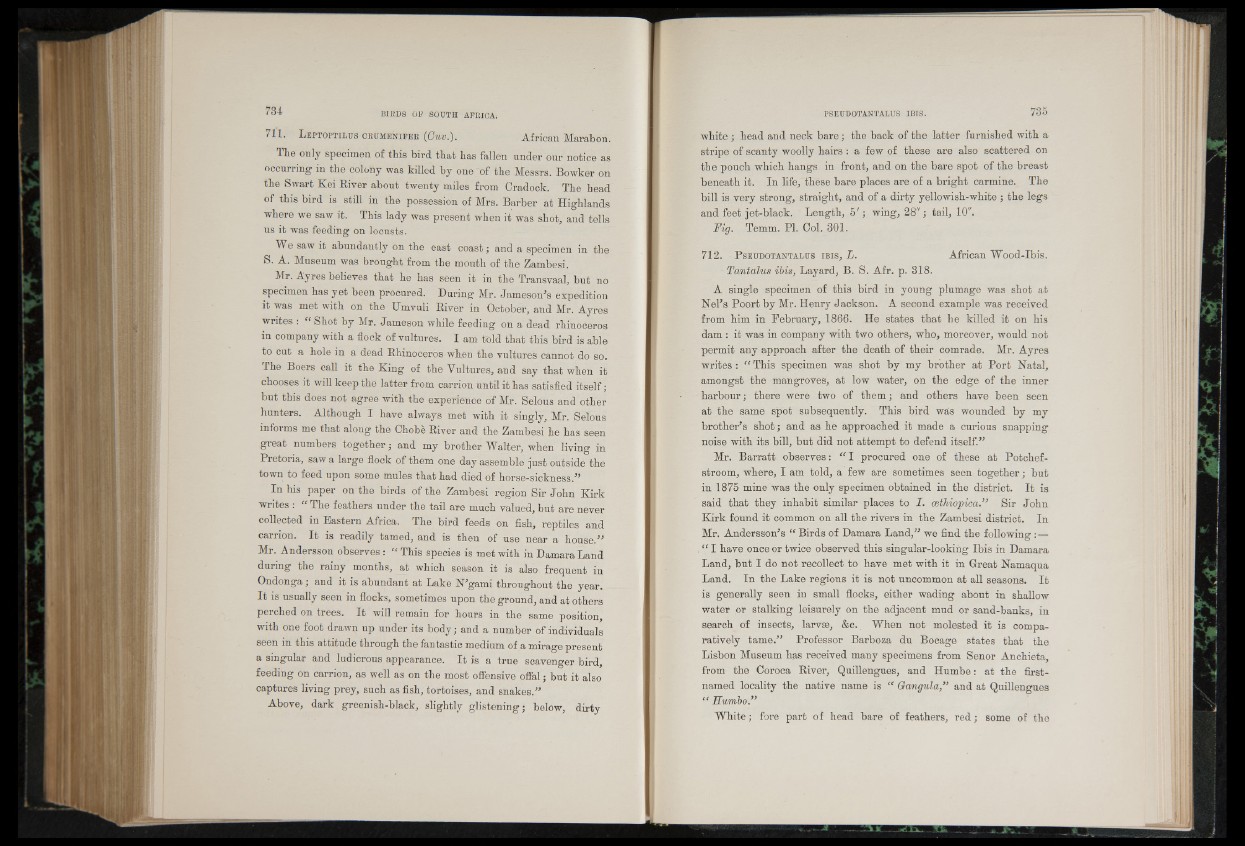
711. L e p t o p t i l u s c r u m e n i f e r (Gu v . ) . African Marabon.
The only specimen of this bird that has fallen under our notice as
occurring in the colony was killed by one of the Messrs. Bowker on
the Swart Kei River about twenty miles from Cradock. The head
of this bird is still in the possession of Mrs. Barber at Highlands
where we saw it. This lady was present when it was shot, and tells
us it was feeding on locusts.
We saw it abundantly on the east coast; and a specimen in the
S. A. Museum was brought from the mouth of the Zambesi.
Mr. Ayres believes that he has seen it in the Transvaal, but no
specimen has yet been procured. During Mr. Jameson's expedition
it was met with on the Umvuli River in October, and Mr. Ayres
writes : “ Shot by Mr. Jameson while feeding on a dead rhinoceros
in company with a flock of vultures. I am told that this bird is able
to cut a hole in a dead Rhinoceros when the vultures cannot do so.
The Boers call it the King of the Vultures, and say that when it
chooses it will keep the latter from carrion until it has satisfied itself;
but this does not agree with the experience of Mr. Selous and other
hunters. Although I have always met with it singly, Mr. Selous
informs me that along the Ohobe River and the Zambesi he has seen
great numbers together; and my brother Walter, when living in
Pretoria, saw a large flock of them one day assemble just outside the
town to feed upon some mules that had died of horse-sickness.’’
In his paper on the birds of the Zambesi region Sir John Kirk
writes : “ The feathers under the tail are much valued, but are never
collected in Eastern Africa. The bird feeds on fish, reptiles and
carrion. It is readily tamed, and is then of use near a house."
Mr. Andersson observes : “• This species is met with in Damara Land
during the rainy months, at which season it is also frequent in
Ondonga; and it is abundant at Lake N’gami throughout the year.
I t is usually seen in flocks, sometimes upon the ground, and at others
perched on trees. It will remain for hours in the same position,
with one foot drawn up under its body; and a number of individuals
seen in this attitude through the fantastic medium of a mirage present
a singular and ludicrous appearance. It is a true scavenger bird,
feeding on carrion, as well as on the most offensive offal; but it also
captures living prey, such as fish, tortoises, and snakes."
Above, dark greenish-black, slightly glistening; below, dirty
white ; head and neck bare; the back of the latter furnished with a
stripe of scanty woolly hairs : a few of these are also scattered on
the pouch which hangs in front, and on the bare spot of the breast
beneath it. In life, these bare places are of a bright carmine. The
bill is very strong, straight, and of a dirty yellowish-white ; the legs
and feet jet-black. Length, 5 '; wing, 28"; tail, 10".
Fig. Temm. PI. Col. 301.
712. P seudotantalus ib is , L. African Wood-Ibis.
Tantalus ibis, Layard, B. S. Afr. p. 318.
A single specimen of this bird in young plumage was shot at
Nel’s Poort by Mr. Henry Jackson. A second example was received
from him in February, 1866. He states that he killed it on his
dam : it was in company with two others, who, moreover, would not
permit any approach after the death of their comrade. Mr. Ayres
writes : “ This specimen was shot by my brother at Port Natal,
amongst the mangroves, at low water, on the edge of the inner
harbour; there were two of them; and others have been seen
at the same spot subsequently. This bird was wounded by my
brother’s shot; and as he approached it made a curious snapping
noise with its bill, but did not attempt to defend itself.’’
Mr. Barratt observes: “ I procured one of these at Potchef-
stroom, where, I am told, a few are sometimes seen together; but
in 1875 mine was the only specimen obtained in the district. It is
said that they inhabit similar places to I. cethiopica.” Sir John
Kirk found it common on all the rivers in the Zambesi district. In
Mr. Andersson’s “ Birds of Damara Land,’’ we find the following :—
1 1 have once or twice observed this singular-looking Ibis in Damara
Land, but I do not recollect to have met with it in Great Namaqua
Land. In the Lake regions it is not uncommon at all seasons. It
is generally seen in small flocks, either wading about in shallow
water or stalking leisurely on the adjacent mud or sand-banks, in
search of insects, larvae, &c. When not molested it is comparatively
tame.’’ Professor Barboza du Bocage states that the
Lisbon Museum has received many specimens from Senor Anchieta,
from the Coroca River, Quillengues, and Humbe: at the first-
named locality the native name is “ Gangula,” and at Quillengues
“ Humbo.”
White; fore part of head bare of feathers, red ; some of the